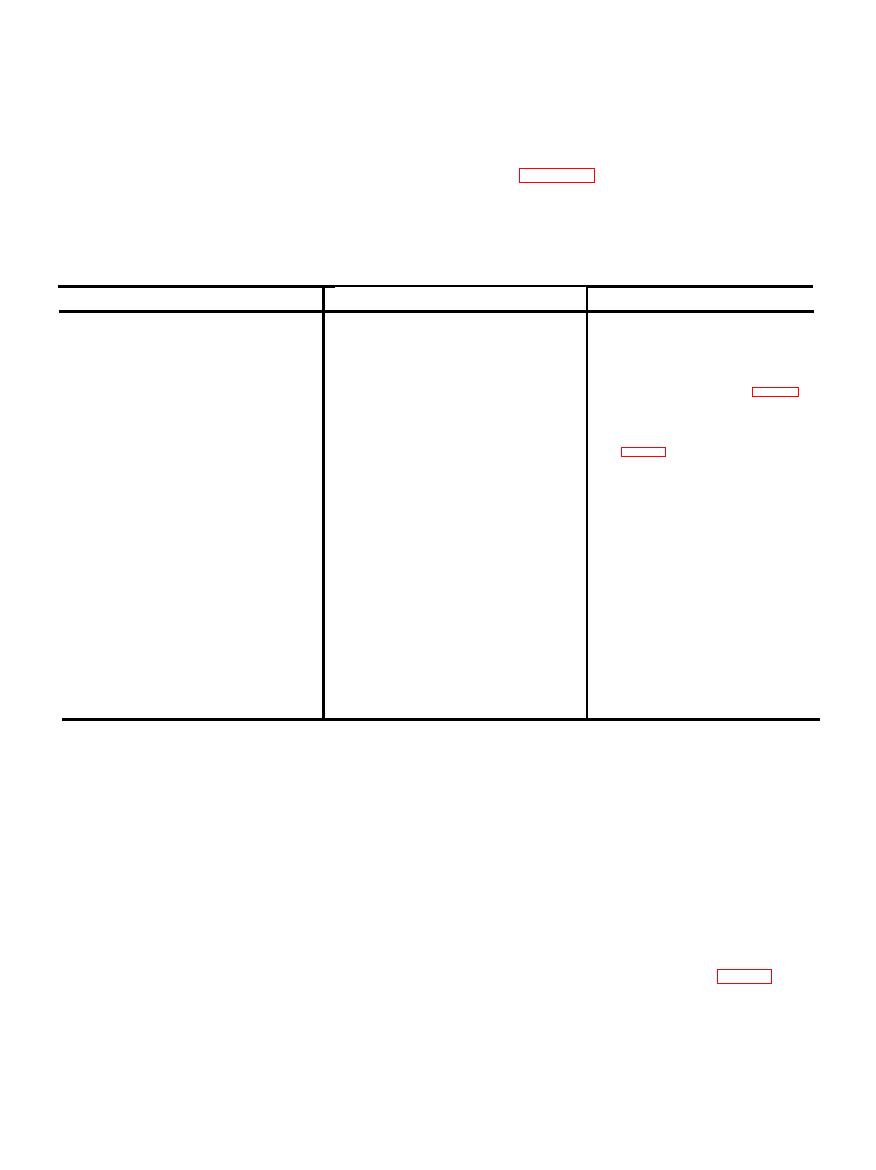 |
|||
|
|
|||
|
|
|||
| ||||||||||
|
|
 Section IV. TROUBLESHOOTING
trouble to
report
the
the
malfunction,
3-6. General
organizational maintenance.
This section describes troubles which might occur
during operation of the pumping assembly, along
3-7. Operator/Crew Troubleshooting Chart
relating to the troubles. O n l y those malfunctions
R e f e r to table 3-2 for troubleshooting which is
w h i c h are within the maintenance scope of the
allocated to the .operator/crew level of main-
operator/crew
are
included
in
this
chart.
If
tenance.
corrective actions given in this chart do not correct
Corrective Action
Probable Cause
Malfunction
a. Fill fuel tank.
a. Fuel tank empty.
1. Engine turns over but fails to
b. D r a i n f u e l t a n k , s e r v i c e f u e l
b. Water in fuel.
start.
strainer (para 3-11). Refill tank
with fresh, uncontaminated fuel.
c.
Close choke for starting (fig. 2-4).
c.
Choke not
closed.
a.
Service fuel strainer (para 3-11).
a.
Fuel filter
clogged.
2. Engine starts but then stops.
b.
Fill fuel tank.
b.
Insufficient
supply of fuel.
c.
Open choke as engine warms up
c.
Choke not
opened after warmup.
a. Fill pump housing with fluid being
a. P u m p h o u s i n g n o t f i l l e d w i t h
3. Engine starts but pump fails to
pumped (para 2-8 b ) .
fluid.
prime.
b. T i g h t e n a l l s u c t i o n c o n n e c t i o n s .
b. Suction leak.
Make sure gaskets are present in
suction fittings.
c. M o v e p u m p c l o s e r t o s o u r c e o f
c. Suction lift too high.
fluid supply.
d. Reduce static discharge head.
d. S t a t i c d i s c h a r g e h e a d t o o h i g h
e. Drain and reprime pump (para 2-
e. Priming liquid too hot.
8b).
a. T i g h t e n a l l s u c t i o n c o n n e c t i o n s .
a. Suction leak.
4. Pump output too low.
b. M o v e p u m p c l o s e r t o s o u r c e o f
b. Suction lift too high.
supply.
c. Lower discharge head.
c. High static discharge head.
Stop pump when long periods of
Pump running at governed speed
5. Pump gets hot
idleness are expected.
with no fluid flow for extended
periods.
Section V. MAINTENANCE OF AIR CLEANER
collects and forms droplets which drain back into
3-8. General
the oil cup, carrying the dirt particles with it. The
a. The air cleaner is mounted on an elbow which
d i r t , being heavier than the oil, settles into the
is secured to the air intake of the carburetor. All air
bottom of the oil cup. It is then removed from the
which enters the engine through the carburetor is
oil cup as the oil cup is cleaned and serviced.
first cleaned by the air cleaner. This removes dirt
a n d other abrasive particles which could cause
rapid engine wear.
a. Daily, or before each operating period, check
b. The air cleaner is an oil-bath type in which the
the level of the oil in the air cleaner oil cup as
incoming air is sucked through the oil in the oil cup
follows :
with some of the oil being entrained in the air. The
( 1 ) Remove the wing nut (1, fig. 3-1) and
oil is deposited in the filter element where it helps to
washer (2) and lift the filter element (3) from the
catch and retain dirt particles in the air. This oil
air cleaner oil cup (4).
|
|
Privacy Statement - Press Release - Copyright Information. - Contact Us |